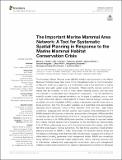Files in this item
The Important Marine Mammal Area network : a tool for systematic spatial planning in response to the marine mammal habitat conservation crisis
Item metadata
| dc.contributor.author | Tetley, Michael J. | |
| dc.contributor.author | Braulik, Gill | |
| dc.contributor.author | Lanfredi, Caterina | |
| dc.contributor.author | Minton, Gianna | |
| dc.contributor.author | Panigada, Simone | |
| dc.contributor.author | Politi, Elena | |
| dc.contributor.author | Zanardelli, Margherita | |
| dc.contributor.author | Notarbartolo di Sciara, Giuseppe | |
| dc.contributor.author | Hoyt, Erich | |
| dc.date.accessioned | 2022-04-19T09:30:03Z | |
| dc.date.available | 2022-04-19T09:30:03Z | |
| dc.date.issued | 2022-03-23 | |
| dc.identifier | 279048506 | |
| dc.identifier | 263987db-11e9-4fd1-ae55-8c94cc772201 | |
| dc.identifier | 85128234659 | |
| dc.identifier | 000780938600001 | |
| dc.identifier.citation | Tetley , M J , Braulik , G , Lanfredi , C , Minton , G , Panigada , S , Politi , E , Zanardelli , M , Notarbartolo di Sciara , G & Hoyt , E 2022 , ' The Important Marine Mammal Area network : a tool for systematic spatial planning in response to the marine mammal habitat conservation crisis ' , Frontiers in Marine Science , vol. 9 , 841789 . https://doi.org/10.3389/fmars.2022.841789 | en |
| dc.identifier.issn | 2296-7745 | |
| dc.identifier.other | ORCID: /0000-0001-8919-4187/work/111972927 | |
| dc.identifier.uri | https://hdl.handle.net/10023/25210 | |
| dc.description | Major support to the IMMA process was provided by the German Federal Ministry for the Environment, Nature Conservation and Nuclear Safety (BMU) on the basis of a decision adopted by the German Bundestag, through the Global Ocean Biodiversity Initiative (GOBI). Funding was also provided by the MAVA Foundation and by the French Biodiversity Agency (OFB) in cooperation with IUCN’s Global Marine and Polar Program. The support from the Prince Albert II of Monaco Foundation, OceanCare, NRDC, the Animal Welfare Institute, and the Pacific Life Foundation is also gratefully acknowledged. | en |
| dc.description.abstract | The Important Marine Mammal Areas (IMMAs) initiative was launched by the Marine Mammal Protected Areas Task Force of the International Union for the Conservation of Nature in 2016, as a response to a conservation crisis in the protection of marine mammals and wider global ocean biodiversity. IMMAs identify discrete portions of habitat that are important for one or more marine mammal species, and that have the potential to be delineated and managed for conservation. They are identified by scientific experts during regional workshops, on the basis of satisfying one or more of eight criteria that capture critical aspects of marine mammal biology, ecology and population structure. Candidate IMMAs undergo independent scientific review prior to being accepted, and then are publicly available via a searchable and downloadable database and a dedicated online e-Atlas. Between 2016 and 2021, eight expert workshops - engaging more than 300 experts - have resulted in the identification of 173 IMMAs located in 90 countries or territories, across a third of the globe. IMMAs identified to date provide important habitats for 58 of the 131 recognized marine mammal species. Around two-thirds of all IMMAs (65%) were identified on the basis of important habitat for a marine mammal species that is threatened on the IUCN Red List. Approximately 61% of IMMA surface areas occur within Exclusive Economic Zone waters, while 39% fall within areas beyond national jurisdiction. The Task Force undertook implementation planning exercises for IMMAs in Palau (Micronesia), the Andaman Islands (India) and the Bazaruto Archipelago and Inhambane Bay (Mozambique), engaging with a range of stakeholders including government and management bodies. IMMAs are increasingly being utilized in environmental impact assessments, marine planning exercises and in international, national and supra-regional conservation, policy and management initiatives, including the Convention on Migratory Species and Convention on Biological Diversity, as well as the design and management of Marine Protected Areas (MPAs) and the extension of MPA networks. The Task Force is working toward completing a global network of IMMAs that will contribute the scientific information needed to fulfill the current collective goal of protecting 30% of the ocean by 2030. | |
| dc.format.extent | 13 | |
| dc.format.extent | 2791282 | |
| dc.language.iso | eng | |
| dc.relation.ispartof | Frontiers in Marine Science | en |
| dc.subject | Ecologically or biologically significant marine areas | en |
| dc.subject | Convention on biological diversity | en |
| dc.subject | Convention on migratory species | en |
| dc.subject | Key biodiversity areas | en |
| dc.subject | Conservation | en |
| dc.subject | Management | en |
| dc.subject | Marine policy | en |
| dc.subject | GE Environmental Sciences | en |
| dc.subject | QH301 Biology | en |
| dc.subject | 3rd-DAS | en |
| dc.subject | SDG 14 - Life Below Water | en |
| dc.subject | MCC | en |
| dc.subject.lcc | GE | en |
| dc.subject.lcc | QH301 | en |
| dc.title | The Important Marine Mammal Area network : a tool for systematic spatial planning in response to the marine mammal habitat conservation crisis | en |
| dc.type | Journal article | en |
| dc.contributor.institution | University of St Andrews. School of Biology | en |
| dc.identifier.doi | 10.3389/fmars.2022.841789 | |
| dc.description.status | Peer reviewed | en |
This item appears in the following Collection(s)
Items in the St Andrews Research Repository are protected by copyright, with all rights reserved, unless otherwise indicated.

